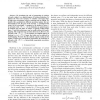Free Online Productivity Tools
i2Speak
i2Symbol
i2OCR
iTex2Img
iWeb2Print
iWeb2Shot
i2Type
iPdf2Split
iPdf2Merge
i2Bopomofo
i2Arabic
i2Style
i2Image
i2PDF
iLatex2Rtf
Sci2ools
CORR
2010
Springer
2010
Springer
Linear Capacity Scaling in Wireless Networks: Beyond Physical Limits?
We investigate the role of cooperation in wireless networks subject to a spatial degrees of freedom limitation. To address the worst case scenario, we consider a free-space lineof-sight type environment with no scattering and no fading. We identify three qualitatively different operating regimes that are determined by how the area of the network A, normalized with respect to the wavelength , compares to the number of users n. In networks with A/ n, the limitation in spatial degrees of freedom does not allow to achieve a capacity scaling better than n and this performance can be readily achieved by multihopping. This result has been recently shown in [7]. However, for networks with A/ > n, the number of available degrees of freedom is min(n, A/), larger that what can be achieved by multi-hopping. We show that the optimal capacity scaling in this regime is achieved by hierarchical cooperation. In particular, in networks with A/ > n, hierarchical cooperation can achieve linea...
| Added | 09 Dec 2010 |
| Updated | 09 Dec 2010 |
| Type | Journal |
| Year | 2010 |
| Where | CORR |
| Authors | Ayfer Özgür, Olivier Lévêque, David N. C. Tse |
Comments (0)

